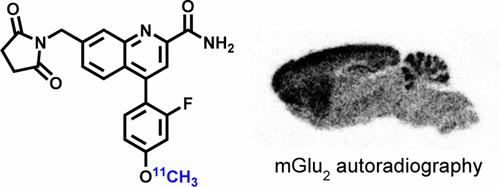当前位置:
X-MOL 学术
›
ACS Chem. Neurosci.
›
论文详情
Our official English website, www.x-mol.net, welcomes your
feedback! (Note: you will need to create a separate account there.)
Synthesis and Preliminary Studies of a Novel Negative Allosteric Modulator, 7-((2,5-Dioxopyrrolidin-1-yl)methyl)-4-(2-fluoro-4-[11C]methoxyphenyl) quinoline-2-carboxamide, for Imaging of Metabotropic Glutamate Receptor 2
ACS Chemical Neuroscience ( IF 4.1 ) Pub Date : 2017-06-13 00:00:00 , DOI: 10.1021/acschemneuro.7b00098 Xiaofei Zhang 1, 2, 3 , Katsushi Kumata 4 , Tomoteru Yamasaki 4 , Ran Cheng 1, 2 , Akiko Hatori 4 , Longle Ma 1, 2 , Yiding Zhang 4 , Lin Xie 4 , Lu Wang 1, 2 , Hye Jin Kang 5 , Douglas J Sheffler 6 , Nicholas D P Cosford 6 , Ming-Rong Zhang 4 , Steven H Liang 1, 2
ACS Chemical Neuroscience ( IF 4.1 ) Pub Date : 2017-06-13 00:00:00 , DOI: 10.1021/acschemneuro.7b00098 Xiaofei Zhang 1, 2, 3 , Katsushi Kumata 4 , Tomoteru Yamasaki 4 , Ran Cheng 1, 2 , Akiko Hatori 4 , Longle Ma 1, 2 , Yiding Zhang 4 , Lin Xie 4 , Lu Wang 1, 2 , Hye Jin Kang 5 , Douglas J Sheffler 6 , Nicholas D P Cosford 6 , Ming-Rong Zhang 4 , Steven H Liang 1, 2
Affiliation

|
Metabotropic glutamate 2 receptors (mGlu2) are involved in the pathogenesis of several CNS disorders and neurodegenerative diseases. Pharmacological modulation of this target represents a potential disease-modifying approach for the treatment of substance abuse, depression, schizophrenia, and dementias. While quantification of mGlu2 receptors in the living brain by positron emission tomography (PET) would help us better understand signaling pathways relevant to these conditions, few successful examples have been demonstrated to image mGlu2 in vivo, and a suitable PET tracer is yet to be identified. Herein we report the design and synthesis of a radiolabeled negative allosteric modulator (NAM) for mGlu2 PET tracer development based on a quinoline 2-carboxamide scaffold. The most promising candidate, 7-((2,5-dioxopyrrolidin-1-yl)methyl)-4-(2-fluoro-4-[11C]methoxyphenyl) quinoline-2-carboxamide ([11C]QCA) was prepared in 13% radiochemical yield (non-decay-corrected at the end of synthesis) with >99% radiochemical purity and >74 GBq/μmol (2 Ci/μmol) specific activity. While the tracer showed limited brain uptake (0.3 SUV), probably attributable to effects on PgP/Bcrp efflux pump, in vitro autoradiography studies demonstrated heterogeneous brain distribution and specific binding. Thus, [11C]QCA is a chemical probe that provides the basis for the development of a new generation mGlu2 PET tracers.
中文翻译:

新型负变构调节剂 7-((2,5-二氧代吡咯烷-1-基)甲基)-4-(2-氟-4-[11C]甲氧基苯基)喹啉-2-甲酰胺的合成和初步研究,用于代谢型谷氨酸受体 2 的成像
代谢型谷氨酸 2 受体 (mGlu2) 参与多种 CNS 疾病和神经退行性疾病的发病机制。该靶点的药理学调节代表了治疗药物滥用、抑郁症、精神分裂症和痴呆症的潜在疾病缓解方法。虽然通过正电子发射断层扫描 (PET) 定量活脑中的 mGlu2 受体有助于我们更好地了解与这些情况相关的信号通路,但很少有成功的例子被证明可以在体内对 mGlu2 进行成像,并且尚未确定合适的 PET 示踪剂。在此,我们报道了基于喹啉 2-羧酰胺支架的放射性标记负变构调节剂 (NAM) 的设计和合成,用于 mGlu2 PET 示踪剂开发。最有希望的候选者 7-((2,5-二氧代吡咯烷-1-基)甲基)-4-(2-氟-4-[11C]甲氧基苯基)喹啉-2-甲酰胺 ([11C]QCA) 以 13% 的放射化学产率(合成结束时未衰减校正)制备,放射化学纯度为 >99%,比活性为 >74 GBq/μmol (2 Ci/μmol)。虽然示踪剂显示脑摄取有限 (0.3 SUV),可能归因于对 PgP/Bcrp 外排泵的影响,但体外放射自显影研究表明脑分布异质性和特异性结合。因此,[11C]QCA 是一种化学探针,为开发新一代 mGlu2 PET 示踪剂提供了基础。
更新日期:2017-06-13
中文翻译:

新型负变构调节剂 7-((2,5-二氧代吡咯烷-1-基)甲基)-4-(2-氟-4-[11C]甲氧基苯基)喹啉-2-甲酰胺的合成和初步研究,用于代谢型谷氨酸受体 2 的成像
代谢型谷氨酸 2 受体 (mGlu2) 参与多种 CNS 疾病和神经退行性疾病的发病机制。该靶点的药理学调节代表了治疗药物滥用、抑郁症、精神分裂症和痴呆症的潜在疾病缓解方法。虽然通过正电子发射断层扫描 (PET) 定量活脑中的 mGlu2 受体有助于我们更好地了解与这些情况相关的信号通路,但很少有成功的例子被证明可以在体内对 mGlu2 进行成像,并且尚未确定合适的 PET 示踪剂。在此,我们报道了基于喹啉 2-羧酰胺支架的放射性标记负变构调节剂 (NAM) 的设计和合成,用于 mGlu2 PET 示踪剂开发。最有希望的候选者 7-((2,5-二氧代吡咯烷-1-基)甲基)-4-(2-氟-4-[11C]甲氧基苯基)喹啉-2-甲酰胺 ([11C]QCA) 以 13% 的放射化学产率(合成结束时未衰减校正)制备,放射化学纯度为 >99%,比活性为 >74 GBq/μmol (2 Ci/μmol)。虽然示踪剂显示脑摄取有限 (0.3 SUV),可能归因于对 PgP/Bcrp 外排泵的影响,但体外放射自显影研究表明脑分布异质性和特异性结合。因此,[11C]QCA 是一种化学探针,为开发新一代 mGlu2 PET 示踪剂提供了基础。






























 京公网安备 11010802027423号
京公网安备 11010802027423号